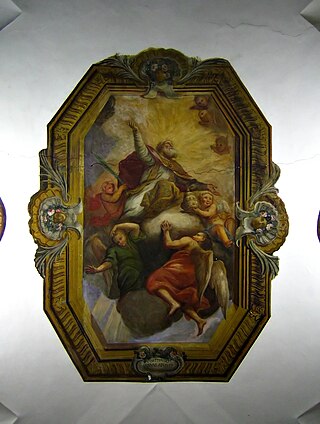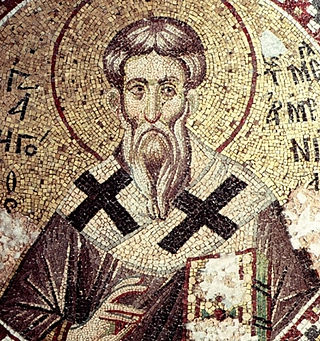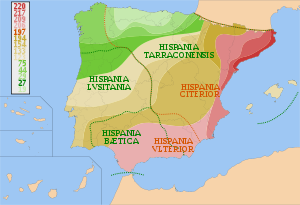
Pope Marcellus I was the bishop of Rome from May or June 308 to his death. He succeeded Marcellinus after a considerable interval. Under Maxentius, he was banished from Rome in 309, on account of the tumult caused by the severity of the penances he had imposed on Christians who had lapsed under the recent persecution. He died the same year, being succeeded by Eusebius. His relics are under the altar of San Marcello al Corso in Rome. Since 1969 his feast day, traditionally kept on 16 January by the Catholic Church, is left to local calendars and is no longer inscribed in the General Roman Calendar.
The 300s decade ran from January 1, 300, to December 31, 309.
The 310s decade ran from January 1, 310, to December 31, 319.
The 270s decade ran from January 1, 270, to December 31, 279.
The 290s decade ran from January 1, 290, to December 31, 299.

Year 302 (CCCII) was a common year starting on Thursday of the Julian calendar. At the time, it was known as the Year of the Consulship of Constantius and Valerius or, less frequently, year 1055 Ab urbe condita. The denomination 302 for this year has been used since the early medieval period, when the Anno Domini calendar era became the prevalent method in Europe for naming years.

Year 273 (CCLXXIII) was a common year starting on Wednesday of the Julian calendar. At the time, it was known as the Year of the Consulship of Tacitus and Placidianus. The denomination 273 for this year has been used since the early medieval period, when the Anno Domini calendar era became the prevalent method in Europe for naming years. The year also saw most lost territories to rebellion returned to the Roman Empire by Emperor Aurelian.

Year 310 (CCCX) was a common year starting on Sunday of the Julian calendar. At the time, it was known as the Year of the Consulship of Andronicus and Probus. The denomination 310 for this year has been used since the early medieval period, when the Anno Domini calendar era became the prevalent method in Europe for naming years.

Hormizd II was king (shah) of the Sasanian Empire. He ruled for six years and five months, from 303 to 309. He was a son and successor of Narseh.

Bahram I was the fourth Sasanian King of Kings of Iran from 271 to 274. He was the eldest son of Shapur I and succeeded his brother Hormizd I, who had reigned for a year.

Bahram II was the fifth Sasanian King of Kings (shahanshah) of Iran, from 274 to 293. He was the son and successor of Bahram I. Bahram II, while still in his teens, ascended the throne with the aid of the powerful Zoroastrian priest Kartir, just like his father had done.

Shapur II, also known as Shapur the Great, was the tenth Sasanian King of Kings (Shahanshah) of Iran. He took the title at birth and held it until his death at age 70, making him the longest-reigning monarch in Iranian history. He was the son of Hormizd II.

Ardashir II, was the Sasanian King of Kings of Iran from 379 to 383. He was the brother of his predecessor, Shapur II, under whom he had served as vassal king of Adiabene, where he fought alongside his brother against the Romans. Ardashir II was appointed as his brother's successor to rule interimly till the latter's son Shapur III reached adulthood. Ardashir II's short reign was largely uneventful, with the Sasanians unsuccessfully trying to maintain rule over Armenia.

Narseh was the seventh Sasanian King of Kings of Iran from 293 to 303.
Cyriacus, sometimes Anglicized as Cyriac, according to Christian tradition, is a Christian martyr who was killed in the Diocletianic Persecution. He is one of twenty-seven saints, most of them martyrs, who bear this name, of whom only seven are honoured by a specific mention of their names in the Roman Martyrology.
The Arsacid dynasty, called the Arshakuni in Armenian, ruled the Kingdom of Armenia from 12 to 428 AD. The dynasty was a branch of the Arsacid dynasty of Parthia. Arsacid kings reigned intermittently throughout the chaotic years following the fall of the Artaxiad dynasty until 62, when Tiridates I, brother of Parthian King Vologases I, secured Arsacid rule in Armenia as a client king of Rome. However, he did not succeed in establishing his line on the throne, and various princes of different Arsacid lineages ruled until the accession of Vologases II, who succeeded in establishing his own line on the Armenian throne, which ruled the kingdom until its abolishment by the Sasanian Empire in 428.

The Sasanian Empire, officially Ērānšahr, was the last empire of ancient Iran. Named after the House of Sasan, it endured for over four centuries, from 224 to 651, making it the second longest-lived imperial Iranian dynasty after the directly preceding Arsacid dynasty of Parthia.
Adur Narseh was the ninth Sasanian King of Kings of Iran briefly in 309. Following his father's death, the nobles and Zoroastrian clergy saw an opportunity to gain influence within the Empire. Thus, they murdered Adur Narseh, blinded one of his brothers and forced another brother (Hormizd) to flee. He was succeeded by his infant brother Shapur II.

The Sassanid Empire or Sassanian Dynasty is the name used for the Persian dynasty which lasted from 224 to 651 AD.

Ifra Hormizd or Faraya Ohrmazd was a Sassanid noblewoman, spouse of Hormizd II and mother of Shapur II. She was the regent during the minority of her son between 309 and 325.













